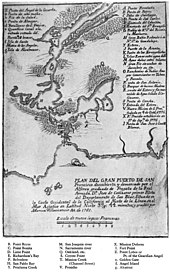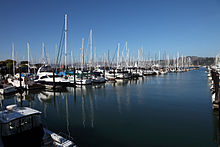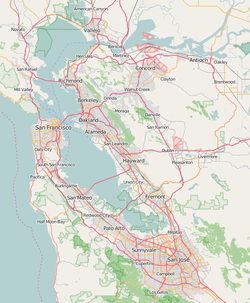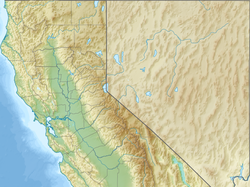|
Sausalito, California
Sausalito (Spanish for "small willow grove") is a city in Marin County, California, United States, located 1.5 miles (2.4 kilometers) southeast of Marin City, 8 miles (13 km) south-southeast of San Rafael,[8] and about 4 miles (6 km) north of San Francisco from the Golden Gate Bridge.[6] Sausalito's population was 7,269 as of the 2020 census.[7] The community is situated near the northern end of the Golden Gate Bridge, and prior to the building of that bridge served as a terminus for rail, car, and ferry traffic. Sausalito developed rapidly as a shipbuilding center in World War II, with its industrial character giving way in postwar years to a reputation as a wealthy and artistic enclave, a picturesque residential community (incorporating large numbers of houseboats), and a tourist destination. The city is adjacent to, and largely bounded by, the protected spaces of the Golden Gate National Recreation Area as well as the San Francisco Bay. EtymologyThe name of Sausalito comes from the Spanish sauzalito, meaning "small willow grove", from sauce "willow" + collective derivative -al meaning "place of abundance" + diminutive suffix -ito; with orthographic corruption from z to s due to seseo. Early variants of the name included Saucelito, San Salita, San Saulito, San Salito, Sancolito, Sancilito, Sousolito, Sousalita, Sousilito, Salcido, Sausilito, and Sauz Saulita.[8] It is sometimes claimed[by whom?] that Sausalito was named for the district in Valparaíso, Chile, where the bandit Joaquín Murrieta was born. Murrieta was the leader of bandits who settled at the northern end of the future Golden Gate Bridge after being banned from San Francisco in the bandit wars. However, this theory is contradicted by sources which state Murrieta was from Mexico, not Chile, and because he did not arrive in California until the Gold Rush around 1849.[9] The Rancho Saucelito had already been granted to William Richardson in 1838.[10] GeographyLocated at 37°51′33″N 122°29′07″W / 37.85917°N 122.48528°W,[6] Sausalito encompasses both steep, wooded hillside and shoreline tidal flats. According to the United States Census Bureau, the city has a total area of 2.2 square miles (5.7 km2). Notably, only 1.8 square miles (4.7 km2) of it is land. A full 21.54% of the city (0.5 square miles, or 1.3 km2) is underwater, and has been so since its founding in 1868. Prominent geographic features associated with Sausalito include Richardson Bay and Pine Point. When Sausalito was formally platted, it was anticipated that future development might extend the shoreline with landfill, as had been the practice in neighboring San Francisco. As a result, entire streets, demarcated and given names like Pescadero, Eureka and Teutonia, remain beneath the surface of Richardson Bay.[11] The legal, if not actual, presence of these streets has proved a contentious factor in public policy, because some houseboats float directly above them. According to the San Francisco Chronicle, "State agencies say privately owned houseboats can't be located above the underwater streets because the streets are public trust lands intended for public benefit." The California State Lands Commission is reportedly pursuing a compromise which would move not the houseboats, but the theoretical streets instead.[12] ClimateSausalito has a Mediterranean climate (Köppen climate classification: Csb) with far lower temperatures than expected because of its adjacency to San Francisco Bay and the resultant onshore breezes.
HistoryIndigenous cultureSausalito was once the site of a Coast Miwok settlement known as Liwanelowa. The branch of the Coast Miwok living in this area were known as the Huimen (or as Nación de Uimen to the Spanish).[14][15] Early explorers of the area described them as friendly and hospitable. According to Juan de Ayala, "To all these advantages must be added the best of all, which is that the heathen Indians of the port are so faithful in their friendship and so docile in their disposition that I was greatly pleased to receive them on board." European settlers took advantage of the Huimen's kindness and hospitality,[citation needed] and completely massacred[citation needed] them within the span of a few generations. As historian Jack Tracy has observed, "Their dwellings on the site of Sausalito were explored and mapped in 1907, nearly a century and a half later, by an archaeological survey. By that time, nothing was left of the culture of those who had first enjoyed the natural treasures of the bay. The life of the Coastal Miwoks had been reduced to archaeological remnants, as though thousands of years had passed since their existence." European arrival and settlement The first European known to visit the present-day location of Sausalito was Don José de Cañizares, on August 5, 1775. Cañizares was head of an advance party dispatched by longboat from the ship San Carlos, searching for a suitable anchorage for the larger vessel. The crew of the San Carlos came ashore soon after, reporting friendly natives and teeming populations of deer, elk, bear, sea lions, seals and otters. More significantly for maritime purposes, they reported an abundance of large, mature timber in the hills, a valuable commodity for shipwrights in need of raw materials for masts, braces and planking. Despite these and later positive reports, the Spanish colonial government of Upper California did little to establish a presence in the area. When a military garrison (now the Presidio of San Francisco) and a Franciscan mission (Mission Dolores) were founded the following year, they were situated on the opposite, southern shore of the bay, where no portage was necessary for overland traffic to and from Monterey, the regional capitol. As a result, the far shore of the Golden Gate strait would remain largely wilderness for another half-century.  The development of the area began at the instigation of William A. Richardson, who arrived in Upper California in 1822, shortly after Mexico had won its independence from Spain. An English mariner who had picked up a fluency in Spanish during his travels, he quickly became an influential presence in the now-Mexican territory. By 1825, Richardson had assumed Mexican citizenship, converted to Catholicism and married the daughter of Don Ignacio Martínez, commandant of the Presidio and holder of a large land grant. His ambitions now expanding to land holdings of his own, Richardson submitted a petition to Governor Echienda for a rancho in the headlands across the water from the Presidio, to be called "Rancho Saucelito".[10] Sausalito is believed to refer to a small cluster of willows, a moist-soil tree, indicating the presence of a freshwater spring.[16] Even before filing his claim, Richardson had used the spring as a watering station on the shores of what is now called Richardson Bay (an arm of the larger San Francisco Bay), selling fresh water to visiting vessels. However, his ownership of the land was legally tenuous: other claims had been submitted for the same region, and at any rate Mexican law reserved headlands for military uses, not private ownership. Richardson temporarily abandoned his claim and settled instead outside the Presidio, building the first permanent civilian home and laying out the street plan for the pueblo of Yerba Buena (present-day San Francisco). After years of lobbying and legal wrangling, Richardson was given clear title to all 19,751 acres (79.93 km2) of Rancho del Sausalito on February 11, 1838. Fishing village and sybaritic enclaveIn the post-Gold Rush era, Sausalito's unusual location became a key factor in its formation as a community. It was San Francisco's nearest neighbor, less than two miles (3 km) away at the nearest point and easily seen from city streets, yet transportation factors rendered it effectively isolated. A boat could sail there in under half an hour, but wagons and carriages required an arduous skirting of the entire bay, a journey that could well exceed a hundred miles. As a result, the region was largely dominated by two disparate classes of people, both with ready access to boats: commercial fishermen and wealthy yachting enthusiasts. Mining townIn the 1870s, manganese was discovered in the hills west of Old Town that was rich enough to justify small-scale mining. Tunnels were dug near the springs between present-day Prospect Avenue and Sausalito Boulevard. Henry Eames, an opportunistic inventor, built an ore reduction plant at the foot of Main Street to process the manganese ore. This location would become the later site of Sally Stanford’s infamous bordello, Valhalla. However, by 1880 the Saucelito Smelting Works was producing only about fifty tons of black oxide annually, hardly enough to make Sausalito a true mining center.[17] Transit hubThe first post office opened in 1870 as "Saucelito" and changed its name to the present spelling in 1887.[8]  In the 1870s, the North Pacific Coast Railroad (NPC) extended its tracks southward to a new terminus in Sausalito, where a rail yard and ferry to San Francisco were established. The NPC was acquired by the North Shore Railroad in 1902, which in turn was absorbed in 1907 by the Southern Pacific affiliate, the Northwestern Pacific. By 1926, a major auto ferry across the Golden Gate was established from the Sausalito Ferry Terminal, running to the Hyde Street Pier in San Francisco.[18][better source needed] This ferry was an integral part of old U.S. Highway 101, and a large influx of automobile traffic, often parked or idling in long queues, became a dominant characteristic of the town. Northwestern Pacific commuter train service also expanded to serve the increased traffic volume, and Sausalito became known primarily as a transportation hub. This era came to an end in May 1937 with the opening of the Golden Gate Bridge. The bridge made large-scale ferry operations redundant, and since the new route of Highway 101 bypassed Sausalito entirely, in-town traffic was quickly reduced to a trickle. Car ferry service ended in March 1941 (passenger ferry service, however, continues to this day, linking downtown Sausalito with both the San Francisco Ferry Building in the Embarcadero, and Pier 39 in at Fisherman's Wharf). Northwestern Pacific also closed its Sausalito terminal in March 1941, although some tracks remained in use as "spur tracks" for freight trains as late as 1971.[16] Bootlegging and rum runnersSausalito was a center for bootlegging during the era of Prohibition in the United States. Because of its location facing the Golden Gate and isolated from San Francisco by the same waterway, it was also a favorite landing spot for rum runners.[19] The 1942 film China Girl has some footage of Sally Stanford's Valhalla restaurant on the waterfront. The scene shows the docks and illustrates rum running. Industrialization during World War IIWhen the United States entered World War II, Fort Barry on Point Bonita was reoccupied. Fort Baker also hosted large numbers of troops. Barracks and other housing were constructed for soldiers. Few of these buildings remain.[20] A major shipyard of the Bechtel Corporation called Marinship was sited along the shoreline of Sausalito. The thousands of laborers who worked here were largely housed in a nearby community constructed for them called Marin City. The soil which supports this area is dredgings from Richardson Bay that were placed during World War II as part of the Marin Liberty Ship shipyards for the United States Navy.[21] A total of 202 acres (0.8 km2) were condemned by the government. A portion of this total area was formed in the shape of a peninsula and this peninsula became known as Schoonmaker Point. In honor of the city's contribution to the war effort, a Tacoma-class frigate was christened the USS Sausalito (PF-4) in 1943. The ship Sausalito, however, was not built in Sausalito but at one of the Kaiser Shipyards in Richmond, California, also on the San Francisco Bay. The Marinship Shipyards were the site of incidents that provided a key early milestone in the civil rights movement.[22] In 1944 in the case of James v. Marinship the California Supreme Court held that African Americans could not be excluded from jobs based on their race, even if the employer took no discriminatory actions. In the case of Joseph James, on whose behalf the suit was brought, the local Boilermakers Union excluded Blacks from membership and had a "closed shop" contract, forbidding the shipbuilder from employing anyone who was not a member of the union. African American workers could join an auxiliary of the union, which offered access to fewer jobs at lower pay. Future US Supreme Court justice Thurgood Marshall successfully argued the case, winning a ruling that the union be required to offer equal membership to African Americans. The court extended the ruling to apply explicitly to all unions and all workers in California. Postwar years  Following World War II, the Marinship Shipyards site owner,[23] Donlon Arques,[24][25] a wealthy inland cattle ranch owner, who preferred hanging out in the junkyard, did basically nothing with the property and let nature take its course.[26]
A lively waterfront community grew out of the abandoned shipyards. By the late 1960s at least three houseboat communities occupied the waterfront along and adjacent to Sausalito's shore. Beginning in the 1970s, an intense struggle erupted between houseboat residents and developers, dubbed the "Houseboat Wars".[27] Forced removals by county authorities and sabotage by some on the waterfront characterized this struggle. This long fight pitted the waterfront against the "Hill People" – the rich on the hill looking down on the waterfront. Today three houseboat communities still exist — Galilee Harbor in Sausalito, Waldo Point Harbor and the Gates Cooperative, just outside the city limit. In 1965, the City of Sausalito sued the County of Marin and a developer from Bridgeport, Connecticut named Thomas Frouge[28] for illegally zoning 2,000 acres (809 ha) of land to build a city named Marincello adjacent to Sausalito.[29] The city won the lawsuit in 1970, and the land was transferred as open space to the Golden Gate National Recreation Area. In 1997, The New York Times compared Sausalito to Devonport in Auckland due to its setting and scenery.[30] In 1972, restaurateur and former San Francisco madam Sally Stanford was elected mayor of the town. GovernmentFederal and stateIn the United States House of Representatives, Sausalito is in California's 2nd congressional district, represented by Democrat Jared Huffman.[31] From 2008 to 2012, Huffman represented Marin County in the California State Assembly. In the California State Legislature, Sausalito is in:
According to the California Secretary of State, as of February 10, 2019, Sausalito has 5,430 registered voters. Of those, 2,905 (53.5%) are registered Democrats, 677 (12.5%) are registered Republicans, and 1,605 (30%) have declined to state a political party.[33]
Demographics
2010The 2010 United States Census[35] reported that Sausalito had a population of 7,061. The population density was 3,128.5 inhabitants per square mile (1,207.9/km2). The racial makeup of Sausalito was 6,400 (90.6%) White, 65 (0.9%) African Americans, 16 (0.2%) Native American, 342 (4.8%) Asian, 10 (0.1%) Pacific Islander, 53 (0.8%) from other races, and 175 (2.5%) from two or more races. Hispanic or Latino of any race were 287 persons (4.1%). The Census reported that 99.8% of the population lived in households and 0.2% lived in non-institutionalized group quarters. There were 4,112 households, out of which 420 (10.2%) had children under the age of 18 living in them, 1,443 (35.1%) were opposite-sex married couples living together, 146 (3.6%) had a female householder with no husband present, 64 (1.6%) had a male householder with no wife present. There were 313 (7.6%) unmarried opposite-sex partnerships, and 63 (1.5%) same-sex married couples or partnerships. 1,927 households (46.9%) were made up of individuals, and 524 (12.7%) had someone living alone who was 65 years of age or older. The average household size was 1.71. There were 1,653 families (40.2% of all households); the average family size was 2.39. The population was spread out, with 615 people (8.7%) under the age of 18, 159 people (2.3%) aged 18 to 24, 1,962 people (27.8%) aged 25 to 44, 2,830 people (40.1%) aged 45 to 64, and 1,495 people (21.2%) who were 65 years of age or older. The median age was 51.1 years. For every 100 females, there were 90.2 males. For every 100 females age 18 and over, there were 89.2 males. There were 4,536 housing units at an average density of 2,009.7 per square mile (775.9/km2), of which 2,088 (50.8%) were owner-occupied, and 2,024 (49.2%) were occupied by renters. The homeowner vacancy rate was 2.1%; the rental vacancy rate was 5.8%. 3,783 people (53.6% of the population) lived in owner-occupied housing units and 3,265 people (46.2%) lived in rental housing units. 2000 As of the census[36] of 2000, there were 7,330 people, 4,254 households, and 1,663 families residing in the city. The population density was 3,852.9 inhabitants per square mile (1,487.6/km2). There were 4,511 housing units at an average density of 2,371.1 per square mile (915.5/km2). The racial makeup of the city in 2010 was 87.4% non-Hispanic White, 0.9% non-Hispanic African American, 0.2% Native American, 4.8% Asian, 0.1% Pacific Islander, 0.3% from other races, and 2.2% from two or more races. Hispanic or Latino of any race were 4.1% of the population. There were 4,254 households, out of which 8.8% had children under the age of 18 living with them, 33.9% were married couples living together, 3.5% had a female householder with no husband present, and 60.9% were non-families. 45.7% of all households were made up of individuals, and 7.8% had someone living alone who was 65 years of age or older. The average household size was 1.72 and the average family size was 2.34. In the city, the population was spread out, with 7.4% under the age of 18, 2.4% from 18 to 24, 39.5% from 25 to 44, 38.5% from 45 to 64, and 12.3% who were 65 years of age or older. The median age was 45 years. For every 100 females, there were 93.5 males. For every 100 females age 18 and over, there were 93.8 males. The median income for a household in the city was $87,469, and the median income for a family was $123,467. Males had a median income of $90,680 versus $56,576 for females. The per capita income for the city was $81,040. About 2.0% of families and 5.1% of the population were below the poverty line, including 5.1% of those under age 18 and 5.5% of those age 65 or over. Sister citiesSausalito has three sister cities, as designated by Sister Cities International: Sakaide is near the Seto Ohashi Bridge on the north coast of the island of Shikoku in Japan (established in 1988). The primary program is a youth cultural exchange program. Viña del Mar is located on the coast of Chile not far from Santiago (established 1960). The relationship features a Sausalito Stadium and a Sausalito Lagoon. Conversely, Sausalito's main plaza is named Viña del Mar in honor of the Chilean city. The primary program is 777 (7 women, 7 days, 7 dreams), an entrepreneurial training for Chilean Woman in Sausalito. Cascais is the newest sister city. This relationship was established in 2013.  MediaFor several decades Sausalito had a local newspaper called the MarinScope,[37] owned at times by Paul and Billy Anderson, and Vijay Mallya. However, as of 2018 the newspaper had ceased publication. Sausalito retains a small radio station founded by Jonathan Westerling, Radio Sausalito 1610 AM, which also serves as the city's Emergency Broadcasting System. The city's primary websites are the city's official site ci.Sausalito.ca.us,[38] the Chamber of Commerce sausalito.org,[39] a reference site oursausalito.com[40] and a guide for locals and visitors to the area Sausalito.com.[41] EducationSausalito is served by the Sausalito Marin City School District for primary school and the Tamalpais Union High School District for secondary school.[42] Effective 2021, the sole public school for the elementary district is Martin Luther King Jr. Academy,[43] with preschool and middle school in Marin City and elementary school in Sausalito.[44] Previously residents had two public schools to choose from: the K-8 public school, then known as Bayside Martin Luther King Jr. Academy, or the K-8 charter school Willow Creek Academy in Sausalito.[45] Willow Creek occupied ground of the former Bayside School in Sausalito. There are two private elementary schools: The K-12 Waldorf-style New Village School, and PreK - 5 campus of the Lycée Français de San Francisco. Headlands Preparatory School offers personalized education for middle and high school students. High schoolers in public school attend Tamalpais High School in Mill Valley.[42] Sausalito City Hall houses the Sausalito Public Library.[46] Parks and recreation The public parks in Sausalito include Cazneau Playground, Cloud View Park, Dunphy Park, Gabrielson Park, Harrison Playground, Martin Luther King Park and Dog Park, Langendorf Park, Marinship Park, South View Park, Robin Sweeny Park, Tiffany Park, Vina del Mar Plaza, and Yee Tock Chee Park. The public beaches include Schoonmaker Beach, Swede's Beach and Tiffany Beach. Sausalito also has a municipal fishing pier and the Turney Street Boat Ramp. A club house/game room and an exercise room are located in the city hall.[47] Houseboats The Sausalito houseboat community consists of more than 400 houseboats of various shapes, sizes, and values, along the north end of town, approximately two miles from downtown.[48] While some of these are technically outside the Sausalito city limits, they are generally acknowledged as forming an integral part of the Sausalito community. The roots of the houseboat community lie in the re-use of abandoned boats and material after the de-commissioning of the Marinship shipyards at the end of World War II. Many anchor-outs came to the area, which created problems with sanitation and other issues. After a series of tense confrontations in the 1970s and 1980s, additional regulations were applied to the area and the great majority of boats were relocated to approved docks. From 77 boats in the water in 1977, there were about 18 boats left in 2019.[citation needed] Several are architect-designed pieces that have been featured in major magazines. The Gates Co-op Houseboat Community remains to this day, although recent action has required them to fit city standards of sanitation and building codes. The humming toadfish makes mating noises underwater, keeping some residents awake at night.[49][50][51][52][53][54] Notable peopleThe following is a list of notable residents of Sausalito, past and present. Past
Present-day
Industry 
In popular cultureBooks, film, television, and video games
Music
See alsoReferences
Further reading
External linksWikivoyage has a travel guide for Sausalito. Wikimedia Commons has media related to Sausalito, California. |
|||||||||||||||||||||||||||||||||||||||||||||||||||||||||||||||||||||||||||||||||||||||||||||||||||||||||||||||||||||||||||||||||||||||||||||||||||||||||||||||||||||||||||||||||||||||||||||||||||||||||||||||||||||||||||||||||||||||||||||||||||||||||||||||||||||||








